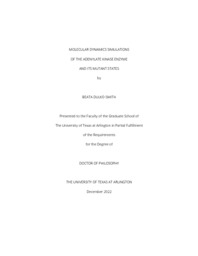
ATTENTION: The works hosted here are being migrated to a new repository that will consolidate resources, improve discoverability, and better show UTA's research impact on the global community. We will update authors as the migration progresses. Please see MavMatrix for more information.
Show simple item record
| dc.contributor.advisor | Nam, Kwangho | |
| dc.creator | Dulko Smith, Beata Izabella | |
| dc.date.accessioned | 2023-06-30T16:13:29Z | |
| dc.date.available | 2023-06-30T16:13:29Z | |
| dc.date.created | 2022-12 | |
| dc.date.issued | 2022-12-19 | |
| dc.date.submitted | December 2022 | |
| dc.identifier.uri | http://hdl.handle.net/10106/31453 | |
| dc.description.abstract | Adenylate kinase (AK) is a small, monomeric enzyme present across all domains of life. It is responsible for maintaining homeostasis of an intracellular adenylate pool and catalyzes a reversible transfer of the phosphoryl group from NTP (nucleoside triphosphate) to NMP producing two NDP molecules. While most known isoforms take ATP as phosphate donor, AK3 present in mitochondrial matrix employs GTP. Crystallographic investigations revealed that the basis for its selectivity for GTP over ATP came from an additional hydrogen bond between guanosine’s O6 and backbone nitrogen of threonine is responsible for recognition of GTP. Molecular dynamics (MD) simulations have demonstrated that stabilization and activation of the substrate are facilitated through a double stacking interaction of guanine’s pyrimidine ring with arginine and phenylalanine, while the AK isoform operating on ATP substrate stabilizes the pyrimidine ring with one π-stacking to an arginine.
AK is not compartmentalized into functionally distinct modules, which would separately control the catalytic step and product release. Therefore, the two events might be connected and mediated by catalytic residues. Enzyme kinetics measurements indicate that the rate of enzymatic turnover and the rate of enzyme opening are of the same magnitude (~ 330 s1), which throws into question the accepted notion that the chemical step is rate limiting. Kinetic data of AK variants, where single-point mutations of the catalytic residues to alanine showed that catalytic activity is quenched upon mutation, did not differentiate if the mutations impacted the chemical step or enzyme dynamics. Using computational methods, the impact on enzyme dynamics is studied with MD simulations and the impact on the energy barrier for the phosphoryl transfer is calculated with hybrid quantum mechanical / molecular mechanical methods (QM/MM). The results show that while QM/MM calculations produced a trend of energy barrier values among the mutant case which linearly correlates to that from the experimental data, AK variants transition towards open conformation quicker than the wild type and suggest that disruptions to the interaction network formed by the catalytic residues trigger untimely opening event. It has been revealed that while the catalytic residues individually control the progression of the chemical step, their organization into a network maintained by a mesh of hydrogen bonds is sensitive to reaction status and responsible for product release. | |
| dc.format.mimetype | application/pdf | |
| dc.language.iso | en_US | |
| dc.subject | Adenylate kinase | |
| dc.subject | Phosphotransferase | |
| dc.subject | Molecular dynamics | |
| dc.title | Molecular dynamics simulations of the adenylate kinase enzyme and its mutant states | |
| dc.type | Thesis | |
| dc.date.updated | 2023-06-30T16:13:30Z | |
| thesis.degree.department | Chemistry and Biochemistry | |
| thesis.degree.grantor | The University of Texas at Arlington | |
| thesis.degree.level | Doctoral | |
| thesis.degree.name | Doctor of Philosophy in Chemistry | |
| dc.type.material | text | |
| dc.creator.orcid | 0000-0002-5732-0633 | |
| local.embargo.terms | 2023-12-01 | |
| local.embargo.lift | 2023-12-01 | |
Files in this item
- Name:
- DULKOSMITH-DISSERTATION-2022.pdf
- Size:
- 14.44Mb
- Format:
- PDF
This item appears in the following Collection(s)
Show simple item record


